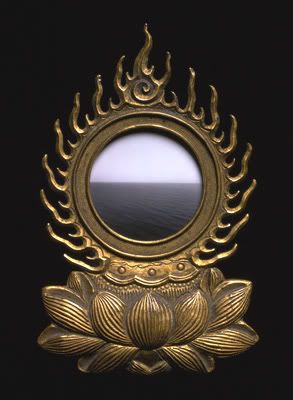SUGIMOTO: History of History
Sugimoto's History of History exhibit at the Smithsonian Sackler Museum of Asian Art:

Time's Arrow
1987
(Seascape, 1980, reliquary fragment,
Kamakura Period, 13th century)
Gelatin silver paint, gilded bronze
H: 8.4 cm
[from Smithsonian]
April 1-July 30, 2006
Arthur M. Sackler Gallery
"Hiroshi Sugimoto: History of History," a unique investigation into the experience of time and history from the perspective of internationally acclaimed artist Hiroshi Sugimoto, will be on view at the Arthur M. Sackler Gallery from April 1 through July 30, 2006. The Sackler presentation coincides with Sugimoto's major retrospective exhibition at the Smithsonian's neighboring Hirshhorn Museum and Sculpture Garden.
Comprised of more than 80 works, "History of History" juxtaposes Sugimoto's own photographs, selected from the artist's well-known series of seascapes, natural history dioramas and wax museum figures, with an enormous range of traditional Japanese and ritual artifacts all drawn from Sugimoto's private collection. The exhibition's contrast of past and present add a new dimension to Sugimoto's photographs, which the artist has famously described as "time exposed."
In "History of History," Sugimoto's preoccupation with the passage of time takes on concrete, multiple forms, as he places photographs from his various series in contexts of history of Japanese art, civilization and ritual. Sugimoto's juxtapositions of photographs with geological specimens and aesthetic objects that he has collected during the past decades, explore time, life and spirituality.
Beginning with visually elegant prehistoric fossils of plant and animal life, the exhibition offers a tour of history that includes ritual objects from Japan's Jomon and Kofun periods (sixth century B.C.E. to seventh century C.E.); religious reliquaries, textiles, mandala, paintings, sutra, and sculpture from the eighth through the 15th century; and a number of recent assemblages in which the artist has combined ancient works or fragments with his own photographs and other contemporary objects. The exhibition embraces an immense span of time, materials and representational processes, from fossilized accretions to mechanical reproductions and stone or bronze ritual objects and sculptures, to silver-gelatin prints. The resulting presentation is a precisely staged, richly evocative construction of history-a history that unfolds through attentive experience and a continual discovery of the past in the present and the present in the past.
Born in Tokyo in 1948, Sugimoto graduated from St. Paul's University in Tokyo in 1970 and left Japan for the United States to study at the Art Center College of Design in Los Angeles, earning a bachelor's degree in 1972. There he absorbed the tenets of Conceptualism and Minimalism, which continue to inform the technical and intellectual rigor of his work. In 1974, he moved to New York City and became a dealer and collector of Japanese and East Asian Art in 1979. During the subsequent decade, according to coordinating curator Debra Diamond, Sugimoto was a frequent visitor to the Sackler and Freer galleries, where he studied the Japanese collections.
The exhibition, which is conceived and curated by Sugimoto, is a joint collaboration among the Arthur M. Sackler Gallery, the Freer Gallery of Art, and the Japan Society in New York City, where "History of History" was heralded as the "Best Museum Show of 2005" by New York magazine. The Sackler presentation is made possible by the Parnassus Foundation and Mr. and Mrs. James Shinn.
At this link there is an interactive online exhibit, but the best part is being able to read what Sugimoto has to say - I found his remarks to be fascinating and profound, especially for parts I & II. There is a podcast available from the Smithsonian: "In this interview Sugimoto discusses his Japanese roots and western influences, the relationship between his role as art collector and his own artwork, and his process of selecting material for this exhibition."DOWNLOAD PODCAST